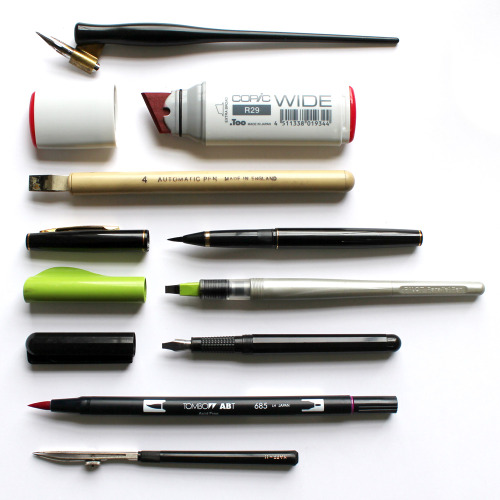typeworship:How to get started in CalligraphyIn this our third guest post, typographer, letterer and
typeworship:How to get started in CalligraphyIn this our third guest post, typographer, letterer and calligrapher Seb Lester gives us an insight into his practices and offers tips to anyone wishing to develop their calligraphy skills. Full videos of above animations here: Destiny and Heart & SoulCalligraphy is enjoying something of a renaissance at the moment. I first noticed at the beginning of 2013 when mainstream publications like Salon started taking an interest in my calligraphy work. Momentum has gathered since then to the point that one of my calligraphy clips has now had over one million views and, due to the interest Instagram have recently taken in calligraphy, I now have 156,000 people following me there. So something is clearly in the air and I find that very exciting. I think a lot of the resurgence of interest is a reaction to the ubiquity of pixels in our lives and indicative of a more general growth of interest in traditional craftsmanship.Many hundreds of people have been asking me questions about how to get started so this seems a perfect opportunity to help promote the practice and appreciation of this beautiful, ancient art form. Calligraphy is a broad term encompassing a wide variety of letterforms. These alphabets have been created with a wide variety of tools over the past 2,000 years or so in the West. One of the attractions for me is that in calligraphy we find the foundations from which typefaces and typography have been built.The key to producing beautiful calligraphy is perseverance. You will only persevere if you enjoy what you’re doing.In terms of broad edge calligraphy tools, necessary for Gothic and Italic styles, ‘Manuscript’ brand calligraphy fountain pens are widely available and practical beginners tools. Pilot Parallel Pens are also great fun and easy to use. As you advance you will probably want to start using traditional metal calligraphy nibs made by established manufacturers like Brause and Mitchell. They can be a bit more difficult to handle but can help achieve finer results.For pointed pen calligraphy, characterised by graceful curves and strong contrasts in line width, I would recommend trying Nikko G nibs. You can use these in either a traditional or an oblique pen holder, it is a matter of personal preference. Iron Gall ink is best for this type of calligraphy. McCaffrey’s and Walker’s Copperplate Ink get great results for me.Paper is always an important consideration. The paper I often use with Pilot Parallel Pens is Daler Rowney Smooth Cartridge Paper, but any smooth cartridge paper should be fine. When I’m working on roughs for any type of calligraphy I often use Goldline Layout paper and Goldline Marker pads. In terms of sketchbooks a lot of calligraphers like the Rhodia brand as the paper doesn’t bleed easily. As with everything the key is to experiment, paper with more texture can produce interesting results too.In terms of books for inspiration I can recommend ‘Scribe: Artist of the Written Word’ by John Stevens, a true modern master. For instruction I would also suggest ‘Foundations of Calligraphy’ by the brilliant Sheila Waters. ‘Calligraphy’ by Gaye Godfrey-Nicholls was published this year, a very good book for beginners. Any of ‘The Speedball Textbook’ series are also inexpensive sources of information and inspiration.The key to producing beautiful calligraphy is perseverance. Progress comes through focused and sustained study and practice. You will only persevere if you enjoy what you’re doing. For this reason I’d personally suggest starting with a calligraphy style you particularly like the look of. When you have a reasonable grasp of that style you will notice many of the skills are transferable to other styles.I feel so lucky to have found what Hermann Zapf described as “this peaceful and noble art”. My working process as a designer and artist has evolved into a hybrid style blending my knowledge of both traditional and digital tools. I think this is a great way to work and as a result I feel I am becoming a better designer and artist every day, which makes me very happy. So if you want to try calligraphy just have fun. Don’t be discouraged by early failures, there will be many of those. However, I can say with some authority that success is built on failure.Above image: Some recommended tools: From top to bottom: Nikko G nib with oblique pen holder, Copic Wide Extra Broad, Automatic Pen, Kuretake Brush Pen, Pilot Parallel Pen, Manuscript Italic Fountain Pen, Tombow ABT Brush Pen, Ruling Pen.See more of Seb’s fantastic work on: Tumblr and Seblester.co.uk -- source link
Tumblr Blog : blog.8faces.com
#ref#long post




